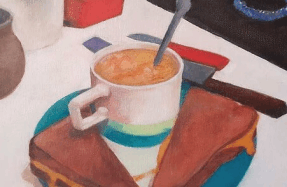New Year, NEW CHALLENGES

1 Build in layers
Sam Coleman challenges you to plan your painting in stages to add a new dimension
THE BENEFITS
Layering basic shapes helps you to create a multi-dimensional portrait with a loose, playful quality, while also capturing interesting textures and colours.
THE PROCESS
Start by choosing a well-lit reference photo with some interesting light and shadows to add some natural sculpting and depth to work with. Draw out a clear sketch. I like to keep my under-drawing visible through the transparent layers of paint, so this essentially acts as the first layer of the portrait. Use this drawing to mark out the more prominent shapes.
Now start adding the paint layers. Do this by first identifying the white areas of your subject – in my case, a French bulldog – so you can preserve them as the highlights. Then add the first layer of paint by applying the lightest non-white value. Next start painting in the medium value layers. I use a wet-on-dry technique for building these layers to avoid any paint bleeding, so this means letting the first layer dry completely before beginning this next layer.
Try to work fast when laying down each layer to keep everything relatively loose. Squint frequently when looking at your subject or reference photo, as this helps to break down the subject into minimal shapes. Identify areas where you can exaggerate the colours, perhaps in the light coming through an ear or the shine on the nose. I build these layers until the correct values are achieved and the subject is sculpted.
Once you are happy with that layer and left it to fully dry, you can then add in the darkest values. These usually occur around the eyes and nose and ear folds. After this step, I check the values to make sure they are correct. Remember that with watercolours you can always add layers to create depth, but you can’t take them away easily, so it’s best to go lighter and then correct at the end.
I like to finish my paintings by using an opaque medium like gouache or pencil, which gives extra dimension and texture, while also allowing for a pop of colour.
2 DRAW FIRST
Loosen up by experimenting with preparatory drawings says Hero Johnson
THE BENEFITS
If you normally plough straight into a
You’re reading a preview, subscribe to read more.
Start your free 30 days





